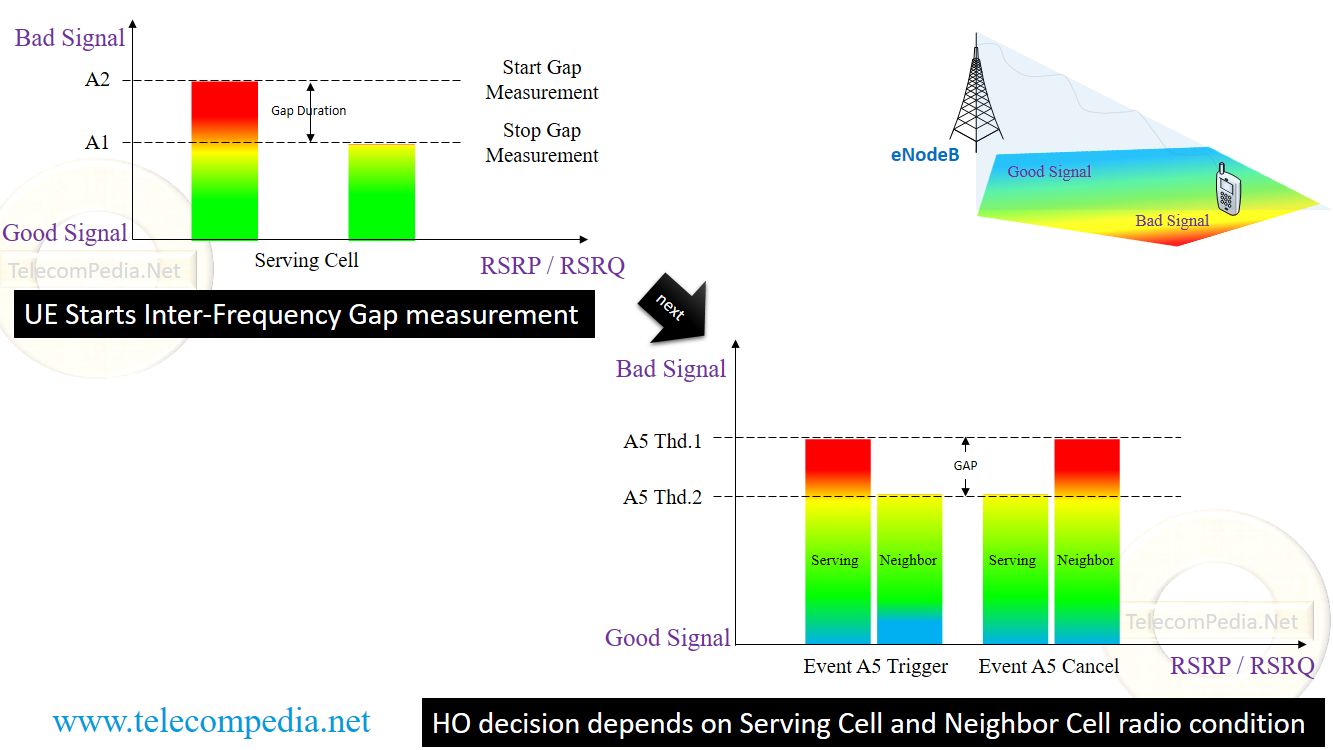Inter-Frequency Handover means mobility in connected mode between two different cells and different LTE frequencies, This topic will be assigned to Event A5 which is used for LTE Inter-Frequency handover. This event type is a little bit different than Inter-Frequency Handover with Event A4. First step is same with event A4 to start gap measurement or stop, but to start handover there are two conditions which was defined with two different thresholds and need to be met for both at the same time (A5 Thd.1 and A5 Thd.2).
It is recommended to have a look HO Events in LTE before reading this topic.
Details:
• LTE Event A2 is triggered when the serving cell becomes worse than a threshold
Event A2 triggering (start measurement for inter-frequency):
Mserv + Hyst < Threshold
• LTE Event A1 is triggered when the serving cell becomes better than a threshold.
Event A1 triggering (stop measurement for inter-frequency):
Mserv – Hyst > Threshold
• LTE Event A5 is triggered when the serving cell becomes worse than A5 Thd.1 while a neighboring cell becomes better than A5 Thd.2. The event is triggered when both of the following conditions are met.
Event A5 triggering (start inter-frequency handover):
Condition#1: Mserv + Hyst < A5 Thd.1
Condition#2: Mneigh + Oneigh,freq + Oneigh, cell – Hyst > A5 Thd.2
Mserv: signal level or quality of the serving cell (RSRP or RSRQ).
Mneigh: signal level or quality of the neighbor cell (RSRP or RSRQ).
Threshold: defined signal thresholds for A1 and A2 to start and stop gap measurement.
A5 Thd.1: defined signal threshold for serving cell.
A5 Thd.2: defined signal threshold for neighbor cell.
Hyst: hysteresis, it is defined in eNodeB and used to avoid ping-pong handover.
Oneigh, cell: Indicates the cell individual offset for the inter-frequency neighboring cell.
Oneigh, freq: indicates the frequency-specific offset for the inter-frequency neighboring cell.
Time to Trigger: this timer helps to avoid irregular measurement and handover.
* Note: all types of triggers is evaluated during Time to Trigger period and occur if the condition stays stable during the period, otherwise the event will be cancelled without triggering.
Conclusion:
Signal of serving cell is poor and UE starts to make measurement with A2 to find better neighbor cell, if the serving cell signal is getting better during Time to Trigger then the UE stops measurement with A1. If it is not getting better during the Time to Trigger then it will make handover with A5 if serving cell signal is below than specified threhold as well as the neighbor cell signal is better than second specified threhold.

Hi,
Could you please provide the source of this information and could you explain why event A4 and A5 are restricted to inter-frequency Handover only?
Hi, it was not restricted. Here mostly used scenario in practice was described.
Hi Ziya,
Thank you for such a useful article!
Could you please explain is there any time duration between checking Condition#1 and Condition#2 or they happens at the same time?
Thanks
Is it possible if A2 not triggered and A5 is triggered in ntwrk :
Scenario : A2 trhld = -140 db, A5 thrld 1 = -105 db and thrld 2 = -104 db
for my test logs i can see :
Events:
EUTRAN RRC A5 Event: PCell/PSCell becomes worse than ‘threshold1’ and neighbor becomes better than ‘threshold2’
Serving Cell RSRP: (24) -117 dBm
Serving Cell RSRQ: (17) -11.5 dB
Neighbors
Cell ID: 54
RSRP: (70) -71 dBm
RSRQ: (26) -7 dB
but there is no IFHO with this measurements as well.
Can you pls give some clear idea what could be the issue…
Yes , No IFHO because A2 not Triggered so A5 also not Triggered